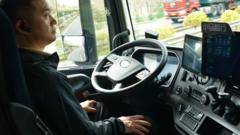On the busy highways connecting Beijing and Tianjin, the future of China's transport industry is being tested with driverless lorries that can navigate without human intervention. While a safety driver remains in the cab due to current regulations, the technology is being developed to eliminate this requirement in the near future. Huo Kangtian, a safety driver, recounts his initial anxiety but expresses growing confidence in the machine's abilities after extensive testing. As a guardian for emergencies, his role is essential for now, although he emphasizes that the autonomous system reduces stress and allows for multitasking.
According to Pony AI’s vice president, Li Hengyu, the shift to driverless operations promises enhanced transport efficiency, lower labor costs, and better adaptability in difficult environments. Technology professor Yang Ruigang states that companies are eager to cut driver expenses, making investment in automated trucks appealing especially as the aim is to bring costs down significantly.
Nevertheless, barriers remain before the widespread rollout of driverless trucks. Public perception is critical, fueled by past incidents, such as an auto-pilot related accident in which three university students lost their lives. Chim Lee from the Economist Intelligence Unit highlights that trust is essential for functioning legislation and market acceptance, particularly as public fears about safety hang heavily over the developments.
In Hefei City, driverless delivery vans have started operating in neighborhoods, successfully integrating with traditional delivery methods — allowing couriers to manage local pickups and drop-offs. With more than 500 vans in operation across 50 cities, the places running these autonomous vehicles are seen as experimental leaders in China’s technological future, recently awarded permissions for broader implementations.
The efficiency of the delivery systems has reportedly increased under the use of these automated vehicles, able to work for longer periods at the same costs as a single human driver. While experts believe that within the next five years, fully autonomous long-haul trucks may be a reality, they acknowledge that the technology is still nascent and the current vehicles are retrofitted older models.
China is poised to lead in this technological revolution, but a cautious approach is essential to counterbalance potential backlash from the public regarding job security and safety concerns. As Professor Yang points out, society is generally more forgiving of human mistakes than those made by machines, highlighting the importance of ensuring the reliability and safety of unforeseen challenges in the implementation of autonomous trucks on public roads.


















